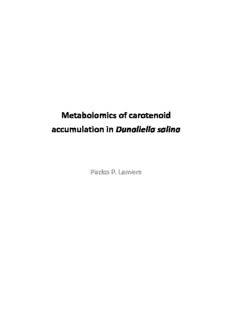
Metabolomics of carotenoid accumulation in Dunaliella salina PDF
Preview Metabolomics of carotenoid accumulation in Dunaliella salina
Metabolomics of carotenoid accumulation in Dunaliella salina Packo P. Lamers Thesis committee Thesis supervisors Prof. dr. ir. R.H. Wijffels Professor of Bioprocess Engineering, Wageningen University Prof. dr. R.J. Bino Professor of Metabolomica of Plants, Wageningen University Thesis co‐supervisors Dr. ir. M.G.J. Janssen Assistant professor, Bioprocess Engineering, Wageningen University Dr. R.C.H. de Vos Senior scientist, Plant Research International, Wageningen University Other members Prof. M.R. Tredici University of Florence, Italy Prof. dr. W.M. de Vos Wageningen University Dr. R.D. Hall Wageningen University Dr. E.J.A. Roebroeck LGem B.V., Voorhout This research was conducted under the auspices of the Graduate School VLAG. Metabolomics of carotenoid accumulation in Dunaliella salina Packo P. Lamers Thesis submitted in fulfilment of the requirements for the degree of doctor at Wageningen University by the authority of the Rector Magnificus, Prof. dr. M.J. Kropff, in the presence of the Thesis Committee appointed by the Academic Board to be defended in public on Friday 11 February 2011 at 1.30 p.m. in the Aula. Packo P. Lamers Metabolomics of carotenoid accumulation in Dunaliella salina 176 pages PhD Thesis, Wageningen University, Wageningen, The Netherlands (2011) With propositions and summaries in Dutch and English ISBN: 978‐90‐8585‐852‐2 Contents Chapter 1 9 General introduction Chapter 2 19 Exploring and exploiting carotenoid accumulation in Dunaliella salina for cell‐factory applications Chapter 3 45 Carotenoid and fatty acid metabolism in light‐stressed Dunaliella salina Chapter 4 73 Carotenoid and fatty acid metabolism in nitrogen‐starved Dunaliella salina Chapter 5 97 Metabolic profiling as a tool in studying stress‐induced carotenogenesis in Dunaliella salina Chapter 6 127 General discussion: Paving the way for optimal productivity of microalgal metabolites Summary 149 Samenvatting 157 Dankwoord 165 Curriculum Vitae 169 Publications 171 Training activities 173 Chapter General introduction 9 Chapter 1 Introduction The finite aspect of our natural resources creates a need for production processes based on renewable resources and/or waste streams. Microalgae are ideally suited to meet such demands, since these microorganisms are able to convert carbon dioxide and water into valuable chemicals using sunlight as the primary energy source. Although plants are equally capable of this, microalgae have become the focal point of recent commercial and academic activities in the field of sustainable production processes. This is mainly because microalgae do not require arable land and have much higher areal productivities than agricultural crops (Chisti 2007; Chisti 2008; Nielsen et al. 1996). These high productivities come at the expense of extra costs though, since they can only be reached in (semi‐)controlled cultivation systems designed to prevent any limitation but light. Because of these high costs, commercial large‐scale cultivation of microalgae is currently limited to the production of high‐value metabolites such as carotenoids and omega‐3 fatty acids (Wijffels and Barbosa 2010). Although these processes typically still use large amounts of energy, and do not yet contribute to the sustainability of our society, they do have high potential to develop into sustainable and economic production processes for microalgal low‐ value bulk chemicals and biofuels. It has been estimated that cost‐effective production requires a 10‐fold reduction in biomass production costs, which should follow from a multidisciplinary approach aimed at realizing breakthroughs in all areas of microalgal biotechnology such as molecular biology, physiology, photobioreactor design and downstream processing (Wijffels and Barbosa 2010). Therefore, several years ago, the project ‘Photosynthetic Cell Factories’ was initiated at the Bioprocess Engineering group of Wageningen University. The objective of this project was to develop the expertise to make high‐efficiency cultivation methods, control of primary and secondary metabolism, strain selection and selective extraction methods possible. For this, the production of carotenoids by Dunaliella salina was used as a model system. This thesis 10
Description: